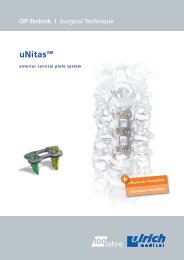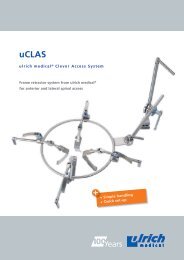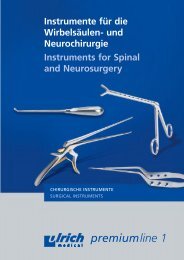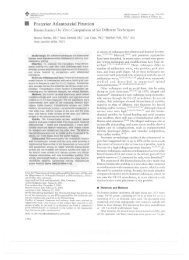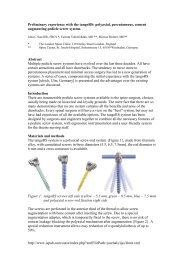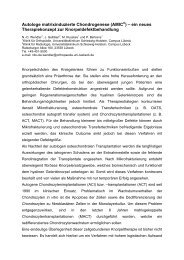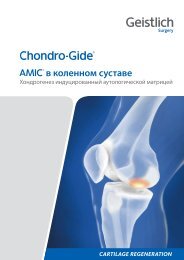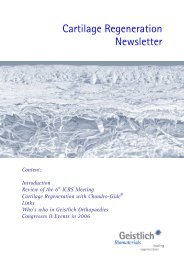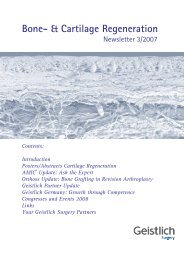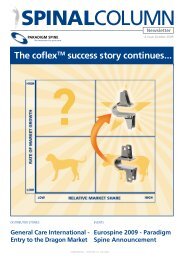Marrow stimulation techniques
Marrow stimulation techniques
Marrow stimulation techniques
You also want an ePaper? Increase the reach of your titles
YUMPU automatically turns print PDFs into web optimized ePapers that Google loves.
S30<br />
M Steinwachs et al<br />
(Geistlich Pharma, Wolhusen, Switzerland) to the microfractured<br />
bone plate, suitable stem cells (hMSC)<br />
can be cultivated. With this autologous regenerative<br />
approach [22,38], the stem cells (hMSC) available in<br />
the bone marrow are brought to the surface by microfracturing<br />
and so become available for cartilage repair.<br />
The collagen matrix serves as a natural scaffold<br />
for cell binding and should stimulate differentiation<br />
processes [13]. The first clinical results of 32 patients<br />
rating clinical functional improvement, pain reduction<br />
and patient satisfaction (ICRS functional status,<br />
Cincinnati score, Lysholm score, VES) as well as the<br />
demonstrated good defect filling in MRI are promising<br />
[1] [Fig. 6]. The outcome was evaluated with a<br />
follow-up of 6 24 months. The mean defect size was<br />
3.9 cm² (1.0 6.8 cm²). Microfracturing in combination<br />
with a collagen matrix (AMIC ® ) is a minimally<br />
invasive, effective technique for the repair of focal<br />
cartilage defects of the knee joint.<br />
Conclusion<br />
The clinical results after microfracturing in the knee<br />
are age dependent. Younger, active patients (< 40<br />
years) with smaller isolated traumatic lesions on the<br />
femoral condyles have the best long-term results.<br />
The deterioration of the clinical results begins after<br />
18 months and is significantly more pronounced in<br />
older patients with defects on the patella-femoral<br />
joint and tibia. For the treatment of smaller cartilage<br />
defects (< 2.5 cm²), microfracturing is a good<br />
Fig. 6: Complete defect filling one year after AMIC ® procedure<br />
on the patella.<br />
first line procedure because it is a minimal invasive<br />
method which does not interfere with other cartilage<br />
repair <strong>techniques</strong>. The AMIC ® procedure seems to be<br />
a promising, cost effective method with good clinical<br />
results in the short term follow up. This procedure<br />
possibly enables better clinical long-term results<br />
in the treatment of larger cartilage defects of the<br />
patello-femoral joint.<br />
References<br />
1. Anders S, Wiech O, Schaumburger J, et al. Autologous matrix<br />
induced chondrogenesis (AMIC®) for focal chondral defects<br />
of the knee First Result. Abstract EFFORT. 2007 Florence,<br />
Italy, Abstract CD<br />
2. Bachmann G, Heinrichs C, Jürgensen I, et al. Comparison of<br />
different MRT <strong>techniques</strong> in the diagnosis of degenerative<br />
cartilage diseases. In vitro study of 50 joint specimens of the<br />
knee at T1.5.Fortschr Rontgenstr. 1997 166: 429−436<br />
3. Becher C, Thermann H. Results of microfracture in the treatment<br />
of articular cartilage defects of the talus. Foot Ankle<br />
Int. 2005 Aug;26 (8):583−9<br />
4. Behrens P. Matrixgekoppelte Mikrofrakturierung. Arthroskopie.<br />
2005 18:193−197<br />
5. Bohndorf K. Injuries at the articulating surfaces of bone<br />
(chondral, osteochondral, subchondral fractures and osteochondrosis<br />
dissecans ). Eur J Radiol. 1996 22: 22−29<br />
6. Brittberg M. Lindahl A, Nilsson A, et al. Treatment of deep<br />
cartilage defects in the knee with autologous chondrocyte<br />
transplantation. N Engl J Med. 1994 331: 889−895<br />
7. Brittberg M. A critical analysis of cartilage repair. Acta Orthop<br />
Scand. 1997 68: 186−191<br />
8. Caplan AI, Fink DJ, Goto T, et al. Mesenchymal stem cells<br />
and tissue repair. In: Jackson DW, Arnoczky SP, Frank CB,<br />
Woo SL-YY, Simon TM, The anterior cruciate ligament: current<br />
and future concepts. Raven Press, New York. 1993<br />
405−417<br />
9. Crawford K, Philippon MJ, Sekiya JK, et al. Microfracture of<br />
the hip in athletes. Clin Sports Med. 2006 Apr;25(2):327−35<br />
10. Dowthwaite GP, Bishop JC, Redman SN, et al. The surface<br />
of articular cartilage contains a progenitor population cell.<br />
J Cell Sci. 2004 29;117(Pt 6):889−97. Epub 2004 Feb 3<br />
11. Dorotka R, Bindreiter U, Macfelda K, et al. <strong>Marrow</strong> <strong>stimulation</strong><br />
and chondrocyte transplantation using a collagen matrix for<br />
cartilage repair Osteoarthritis Cartilage. 2005 13(8):655−64<br />
12. Erggelet C, Steinwachs M, Reichelt A. Die Behandlung von<br />
Gelenkknorpeldefekten. Dtsch Arztebl. 1998 95: 1397−1382<br />
13. Friedman MJ, Berasi CC, Fox JM, et al. Preliminary results<br />
with abrasion arthroplasty in the osteoarthritis knee. Clin<br />
Orthop. 1984 182: 200−205<br />
14. Fuss M, Ehlers EM. Characteristics of human chondrocytes,<br />
osteoblasts and fibroblasts seeded onto a type I / III collagen<br />
sponge under different culture conditions. A light scanning<br />
and transmission electron microscopy study, Anat Ann. 2000<br />
182(4): 303−310



